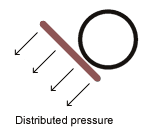History
First vehicles powered by the steam engine started to appear in the early 1800s. Various machines started slowly replace horses. It was especially true for the jobs that required a lot of power. Transportation, of course, was the first and the most beneficial adopter. Goods could be carried across large distances with relative ease. No wonder that farmers were also eager to adopt engines. By that time most of the work was done using horses and basic tools.
Problems

Steam powered harvesters and tractors were introduced by the end of 19th century. It started to gradually replace horses. However in some regions they created new problems as well. Vehicles proved to be too heavy for soft soils and often stuck and even sunk. Experiments with various sizes of wheels didn't produce good results. Increasing size of wheels just made vehicles heavier and more difficult to operate.
Benjamin Holt of Holt Manufacturing figured that using an old trick of pouting planks before the wheel would improve cross-country ability. By doing so, it provides solid plane for better traction and lower pressure on the ground since size of the plank is larger then of the wheel. Read more about physics behind it.